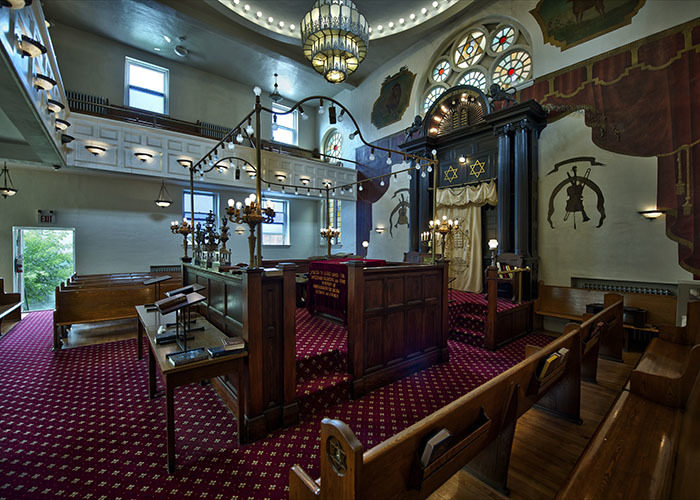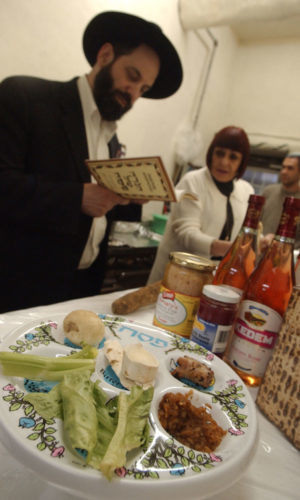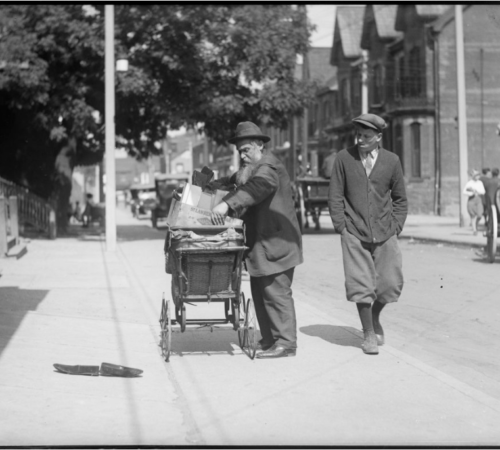The Anshei Minsk synagogue is located in Toronto’s Kensington Market. It is an imposing brick building sandwiched between a Rastafarian store and a Korean restaurant on St. Andrew’s Street. From the outside the shul looks derelict. The stone facade is weather beaten and dirty; its large red doors could use a fresh coat of paint. You enter the building from the south, but the chapel inside is oriented towards the east so that, as per custom, congregants can pray towards Jerusalem. The sanctuary within betrays signs of its former opulence. A large chandelier is suspended by a thick white-painted chain from the centre of a light-blue dome.
Several of the glass panels on the fixture are missing, and many of the incandescent bulbs are burnt out or absent altogether. Some of the shul’s windows are gone, and in their place garbage bags have been taped to the panes. Above the altar, a wooden star of David is missing one of its constitutive line segments. The room feels cluttered. The space under the back pew is occupied by hundreds of prayer books. A few are stored in a red Budweiser box. Paul Shkolnik, one of the Minsk’s congregants, best summarized the state of the shul when he said, “it is not in a state of disrepair, it is disrepaired.”
An introduction
When I walked into the Minsk for the first time, the rabbi seemed excited. For synagogues, younger people represent survival and we are therefore a hot commodity. He asked for my Hebrew name and I told him it was ‘Yosef’. He asked for my family name, and we played ‘Jewish geography’; a game in which Jews mine their respective social circles for mutual acquaintances. There was little overlap between my Jews and his, but my last name gave him a flash of inspiration. He grabbed a red book off the shelf and showed me a passage in which the biblical Joseph was instructed by God to ‘proliferate like Fish.’ The rabbi interpreted this as proof that my presence there was preordained. “It’s all in the Torah,” he said.
During the service, the rabbi leaned out over the pulpit’s wooden railing and called out to me. “Joseph,” he said, “how often do you work out?” I told him that I usually exercise two or three times a week. The answer was acceptable, and he invited me to come up and join him and his assistant, or gabbai, at the altar. He told me to pick up the opened Torah scroll by its wooden handles and turn 360 degrees while holding it above my head. There were about seven men in the pews and few of them seemed to be paying attention. At least one was asleep. A single bespectacled woman looked down on me from the balcony. We made eye contact but she did not smile.
Later on, Paul Shkolnik walked in wearing a green parka and wool-lined checkered hunting cap (the Minsker had no yarmulkes to lend, I wore my beanie as a head covering). He was wandering through the sanctuary muttering to himself. The rabbi asked him to come up to the pulpit. When a rabbi invites a congregant to come participate in the service it is called an ‘aliyah’, and it is typically considered an honor for Jews. Shkolnik responded with a flat ‘no’. “You claim to be the chosen people,” he said, “…but you are always choosing someone else!”

The man behind the Minsk
Rabbi Shmuel Spero has been the rabbi at the Minsk for 32 years, the longest anyone has held the position since the shul’s founding in 1912.

The rabbi is short and mostly bald with a grey beard. Early old-age is evident in the creases on his face and forehead but his eyes have retained a youthful luminescence. He moves with the frenetic energy of a 20-something. He is quick-witted, with a benevolent smile— an attribute that may be a prerequisite for graduation from rabbinical school.
Rabbi Spero was born into the Orthodox Jewish community in Cleveland, Ohio. In 1988 he was studying in a yeshiva in Israel when a Jewish organization reached out to him to ask if he would fill the vacant rabbi position at the Minsker. He initially agreed to sign on for a 6-month contract. He says he stayed on longer because he “enjoyed the involvement in people’s lives, the teaching.”
The rabbi’s commitment to his congregation has garnered the Minsk a small group of devoted congregants, but the synagogue often struggles to attract sufficient numbers for their services. Being Orthodox, the shul subscribes to the belief that ten Jewish men, or a minyan, must be present for the proper performance of Jewish religious rites. The Minsk does not always reach this benchmark, and Rabbi Spero routinely goes out into the surrounding community in search of Jews he can convince to come inside to boost the numbers.
"We pull em' in"
Cyril Levitt, a longtime friend of my family, has witnessed the lengths the rabbi will go to to get his minyan. One night, he was eating with his daughter at Pho Hung, a Vietnamese restaurant one block away from the Minsk. “I’m sitting there and I’m eating, my back is to the window,” he said. “My daughter goes white, and she says, ‘Dad, Rabbi Spero is staring at us’.” The rabbi was at the window looking in at them. Levitt went to the bathroom, hoping that Rabbi Spero would be gone by the time he came back. When he returned to the table, the rabbi was no longer there. “I sat down, relieved, then my daughter says, ‘Dad, look beside you’, and Rabbi Spero is in the restaurant standing next to my chair,” he said. The rabbi told Levitt that they needed a tenth man for a minyan and asked if he would be willing to come to the synagogue for a few minutes. Levitt agreed while doing his best to conceal the pork on his plate.
Harold ‘Hesh’ Troper is a writer and historian who focuses on Canadian Jewry. A few years ago he was asked to give a tour of ‘ethnic Toronto’ to a group of schoolteachers from West Virginia. “I may have been for some of them the first Jew they ever met,” he said. He was standing on the south side of St. Andrews Street telling his group about the synagogue when he received a tap on the shoulder. “This little guy says, ‘are you Jewish?’ and I said yeah, he says ‘we need a tenth.’” Troper told him that he would be unable to help him because of the 20 West Virginians relying on him to finish the tour. Rabbi Spero told Troper to bring them in with him. “And in we went,” said Hesh. The service was being held in the basement, and the Americans watched from the wings as the men prayed. They were enthralled by the display that was entirely alien to them, and by the smoked herring and schnapps offered to them at the service’s conclusion. “They had died and gone to heaven,” said Troper.
When asked how he is able to tell when someone is Jewish, Rabbi Spero said that it is in their eyes. “The eyes of Jews are full of Jewish history,” he said, before adding, “looking Jewish is also helpful.”
Left behind
There was a time at the synagogue where rabbis did not have to resort to pulling people in off the street. For the first half of the 20th century, The Minsk served as a hub for Jews in Kensington Market which was itself the centre of Toronto Jewish life. According to the Canadian Encyclopedia, there were at least 30 synagogues operating in the area at the time. Many of the shuls, including the Minsk, catered to populations from specific Eastern European cities and towns. The diversity of congregations demonstrated the truth in the old adage that ‘where there are two Jews, you’ll find three opinions’.
The Anshei Minsk was founded in 1912 by Belarusian Jewish immigrants. At the time, thousands of recently arrived Jews were living amid squalid conditions in a neighbourhood called St. John’s Ward. By 1910, many of these migrants had seen a marked reversal in their economic fortune, and began moving into Kensington to escape the squalor of ‘The Ward’. Many sold wares out of push carts, or set up stalls on the ground floor of their homes to sell produce or livestock. The area took on the moniker of ‘The Jewish Market’.
In the 1950s, Jewish people began leaving Kensington in droves. Many of them moved northward along Bathurst street into North York and the suburb of Thornhill. Some of the Kensington-area synagogues relocated to cater to the shifting demographics, but most closed down entirely.
The Minsk remained in operation, and continued to fill its pews as a so-called ‘businessman’s shul’. Jews working in the garment factories along Spadina Avenue would come to the Minsker to pray before and after work.

Beginning in the 1970’s, the textile industry began to move overseas and the factories along Spadina closed. From then on the shul sustained itself by catering to the few Jews who remained downtown, and to students from the nearby University of Toronto. Some of the descendants of the original founders would also patronize the synagogue, on occasion. Eventually, however, even those sources of congregants began to dry up and the Minsk looked like it might go the way of its fellow Kensington shuls. Many credit Rabbi Spero for keeping it alive to this day.
Resurgence
Ron Wiseman, a musician who has been called, ‘The King of Jewish Reggae’, began attending the Minsker in the late 80’s. He says that before Rabbi Spero’s arrival, the congregation was in decline. “It was dying,” he said, “[Spero] brought it back to life.” Wiseman says that Spero would hold Shabbat dinners that attracted Jewish travellers from downtown hotels, and sick people and their relatives from the nearby hospitals. “It could be a Nobel laureate or a guy who’s down and out without ten cents in his pocket… you’re all at the same table,” he said.
Wiseman sent me a video taken during the Minsker’s Purim party in 1993, five years into Rabbi Spero’s tenure. The hour-long video shows the Minsk basement packed with people. Wiseman himself is leading the band providing music for the party. They play Jewish standards like ‘Hava Nagila’ intermingled with his trademark Jewish-tinged reggae. Some of the partygoers dance in groups in the middle of the room while others gab animatedly on the sidelines. The crowd is made up of men and women, young and old. Children are running around.
The video concludes with an inebriated man standing in the middle of the sanctuary wearing a king’s crown and sunglasses. His large beard is tied up into knots. His face is illuminated by a lamp in an attempt by the cameraman to make him look messianic. He tearfully pleads with the camera for the Jewish people to “come home” to Israel. He says that, “if you don’t come home, you deserve everything you get. Don’t cry ‘another Holocaust, another Holocaust.’ You deserve it.”
The fire
Over the next decade, many of the older congregants died and a number of the younger ones began to move away. The shul was struggling to stay afloat, when tragedy struck.
On the morning of March 11, 2002 an unknown assailant broke in the back door of the synagogue and started a fire on the upper balcony of the sanctuary that caused hundreds of thousands of dollars in damages.
The blaze nearly destroyed several boxes of old prayer books, some dating back to the 19th century. Rabbi Spero said he laid out the books on the floor of the basement to survey which to save or condemn. No motive was ever definitively established, but it was widely assumed that the attack was driven by antisemitism.
According to Rabbi Spero, the synagogue saw an “outpouring of support from the Jewish and non-Jewish community” in the wake of the fire. He says it also generated curiosity, as people were fascinated by the fact that Jewish people bury damaged prayer books as if they were dead people. An article in the Globe and Mail referenced the rabbi’s hope that the incident would attract new people to the Minsk and rejuvenate the synagogue. In the end it never came to fruition. Eventually most of the damage was repaired, but after the media hype subsided, attendance did not appreciably improve.
"A Place of refuge"
Today, Rabbi Spero says that the Minsker location in the heart of downtown Toronto means that it attracts a varied clientele, including “stragglers and the disenfranchised.” He says that instead of turning them away, the shul “adjusts to them.” The rabbi is devoted to his congregants, and for many, the shul seems to play a larger role in some of their lives than a synagogue normally would. Rabbi Spero says he sees the Minsk as more than just a place for prayer. “People find the shul as a place of refuge, of protection,” he said. “[It’s] a home for some.” He means that literally. The rabbi routinely allows people to sleep in the synagogue when they have nowhere else to go.
Corinne Levitt, Cyril’s wife, has been attending the Minsk on the Jewish high holidays for around nine years. Once, while inside the synagogue, she observed the strength of Rabbi Spero’s commitment to the community. “So I’m sitting and it’s sort of a balcony, and I can see under the bench from where I’m sitting on the other side, and I went, ‘I think that bedroll just moved,’” she said. “At first I thought, ‘Is it a rat? Is it a raccoon?’ So I look, [and] it’s someone sleeping.” Instead of being put off, Corinne said the sight made her happy. “What other shul in the city — I’m sure he wasn’t Jewish — would allow a guy to just tuck in and have his little nap there?”
Eggs
My third visit to the synagogue was for Friday morning services. It was the coldest day of the year, and when I arrived at 8 a.m., there were three men waiting at the doors for someone to let them in. The synagogue has no full-time employees other than Rabbi Spero. There is no caretaker to open the door or sweep the floors, no secretary to answer the phone or respond to emails. Noah Zaccharin, the gabbai, put it best when he said, “there is no shul, there is only Rabbi Spero.” I went to seek coffee and warmth in a nearby cafe and when I returned to the shul ten minutes later the doors were open.
After the service, Rabbi Spero invited me to eat some eggs in a basement room that he called “the most productive space.”There was clutter everywhere. In the corner, a man slept on a makeshift bed made of chairs. On the walls there were pictures from the shul’s halcyon days, including a photograph of a group of men and women seated at what looked like a Passover seder table.
Spero walked around the basement retrieving miscellaneous things from various nooks. While doing so he told me about Korah, a biblical figure who was literally swallowed by the Earth as punishment from God for rebelling against Moses.
The rabbi brought out the first plate of eggs, and despite my trepidation about eating anything prepared in that basement, I took a plateful to be polite. They were a bit runny, but the rabbi mixed in Shawarma spice, which made them edible. The sleeping man got up and joined us at the table as the rabbi brought in the second bowl of scrambled eggs. Into this batch he mixed in some tomato and mango salad leftover from a past Shabbat. I abstained from this round. During the meal he received a call from his son in Israel and it ran long. I had to go before we got the chance to talk. As I was leaving I said, ‘keep in touch.’
“It’s the only way to be,” Rabbi Spero replied.
"Come back tomorrow"
Paul Shkolnik has been attending the Minsker regularly since 2004. At 52, he is tall and sturdy. He speaks with a thick Russian accent that he has retained since moving to Hamilton, Ont. from Azerbaijan at the age of 12. He is funny, and often sends himself into heaving fits of laughter. Shkolnik said that when he first came to the shul he, “thought it was just a fly-by-night operation,” and that the congregants, “didn’t seem well off, mentally.” What kept him there was the rabbi. “[Rabbi Spero is] very forgiving, he holds no grudges, and he’s funny as hell,” he said. To illustrate the latter point, Shkolnik told me that he once asked Spero a simple question about the Torah, to which the rabbi responded, “none of your business.”
He explained that the rabbi could be incredibly patient in his dealings with some congregants, who might show up intoxicated and even physically aggressive. “He would escort them out, and say, ‘come back tomorrow,’” Shkolnik said.
If Rabbi Spero is upset about the physical state of the shul, or the sometimes disruptive congregants, or their struggle to fill seats, he does not show it. During services he sings and dances enthusiastically, regardless of how many are in attendance. Despite the aging congregation, and the physical deterioration, he maintains that “the best is yet to come” for the Minsk. Of the much needed repairs, he said, “it’s all gonna happen when it has to happen.”
Rinse and repeat
I was at the Minsk a few Saturdays after my first visit to the shul. That morning, we had 12 men, including a few older ones who had made the trip downtown from Thornhill. One of them moved with the aid of two canes. Thinking about him walking up and down the large stairway leading to the entrance made me nervous.
When the suburb-dwellers departed, we were left one short of the 10 we needed. The other congregants were content with calling it a day, but the rabbi was not.
It was freezing cold outside, but still Rabbi Spero braved the bitter elements, determined to find an unsuspecting Jew to complete his minyan.

